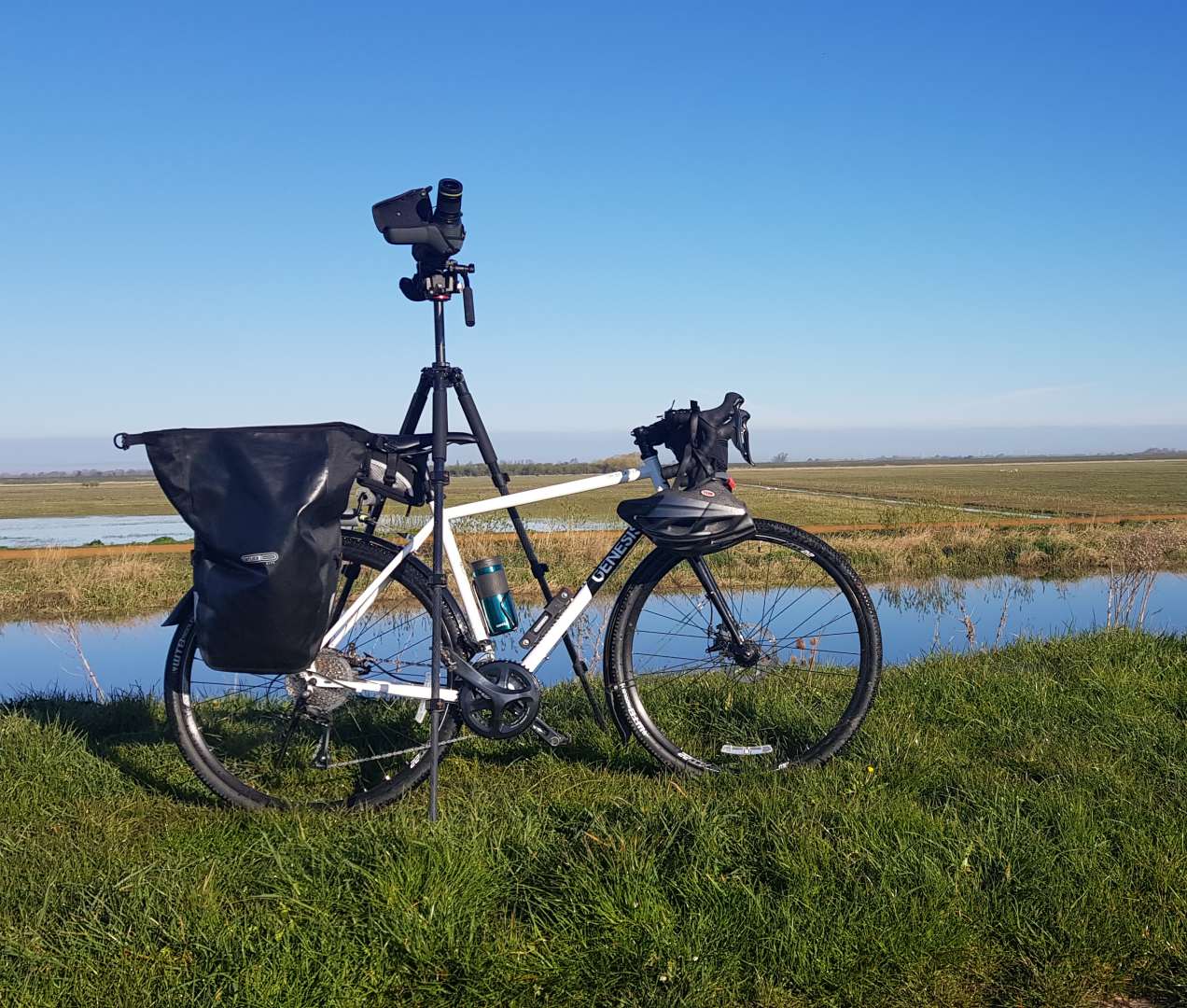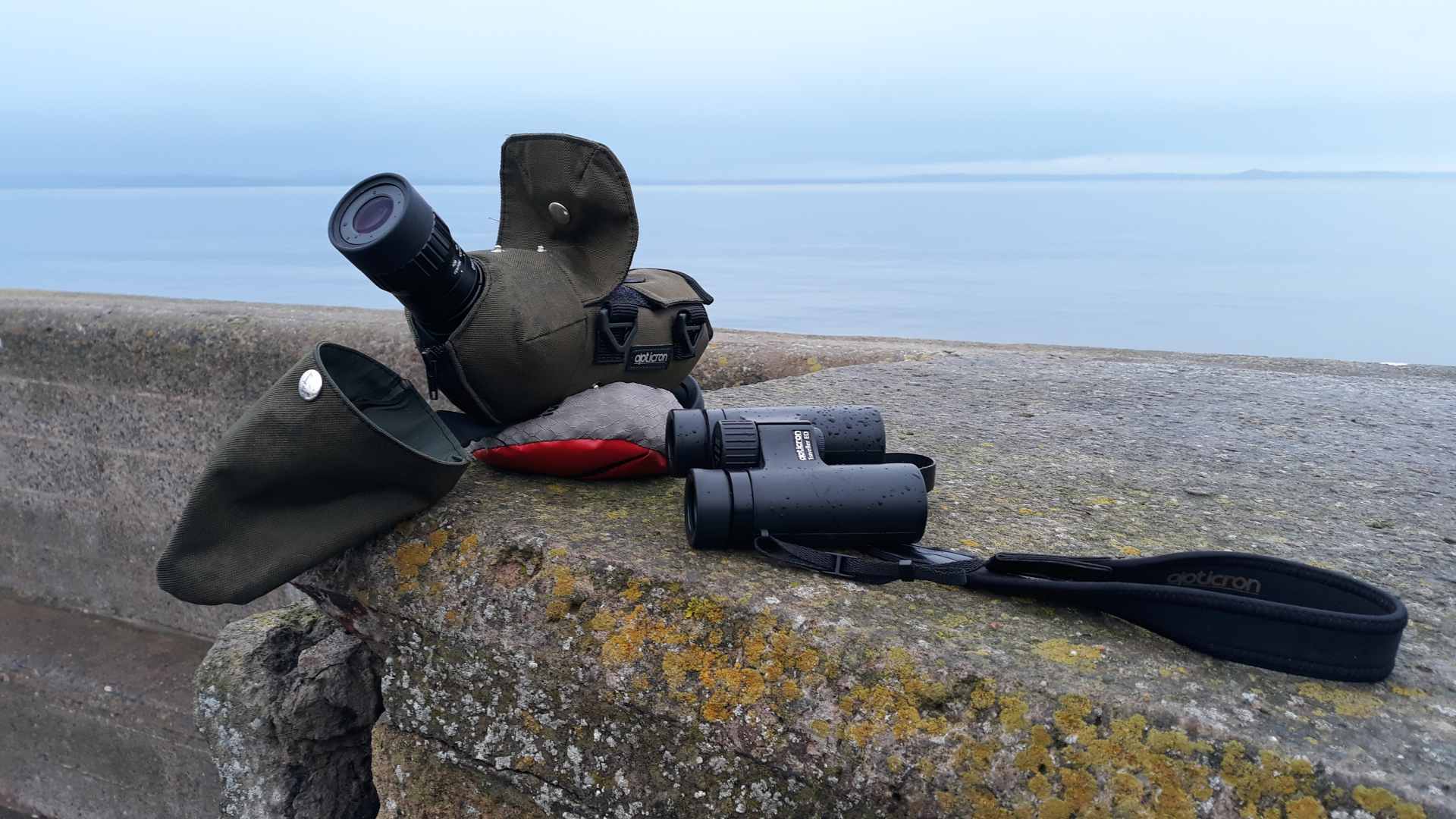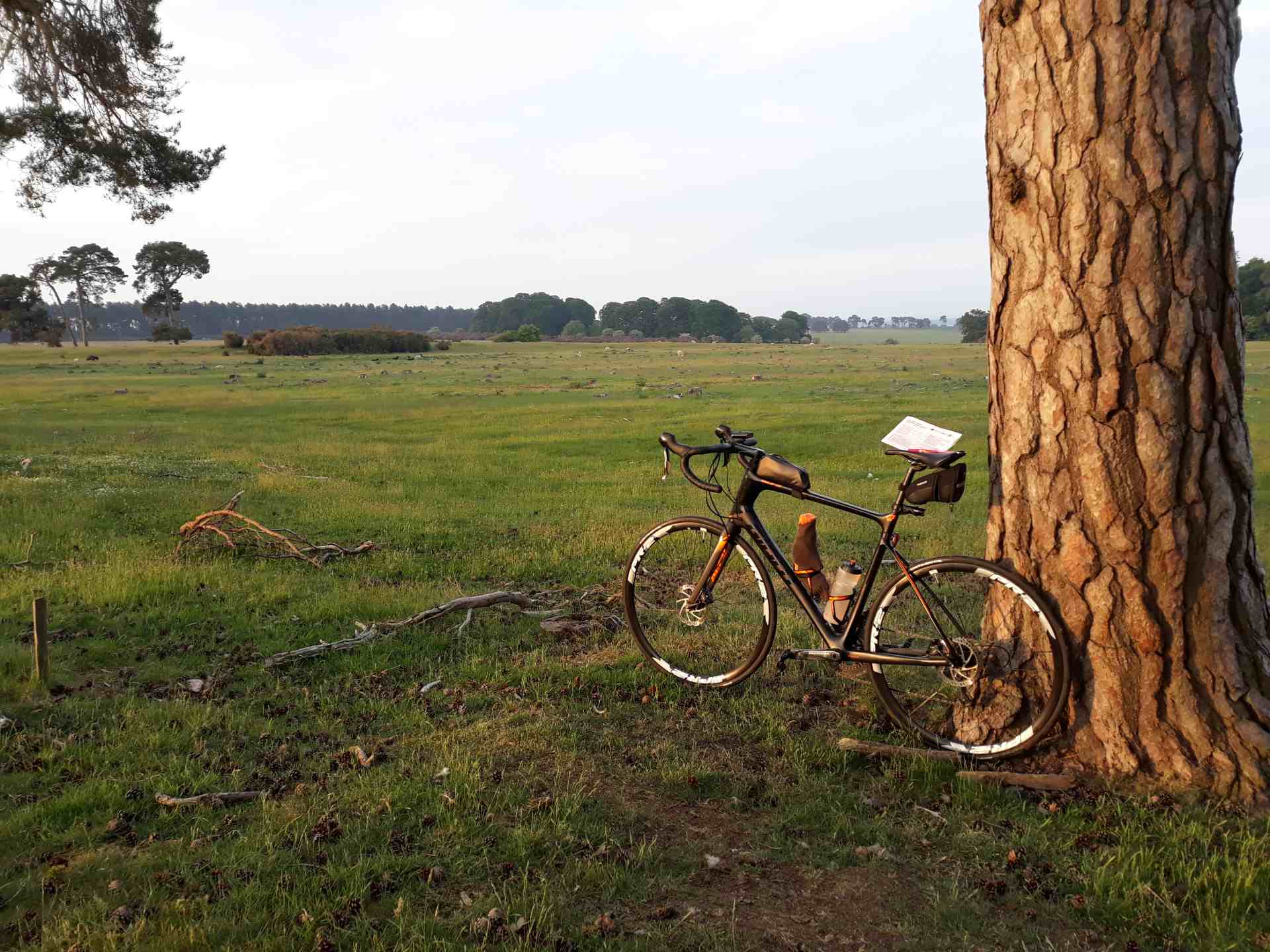I've been keen on cycling – and mad-keen on birding – for almost four decades. You'd be forgiven for thinking that by now I’d have successfully combined the two. The truth is, I haven't. Birding has been unwavering as my number one passion (or obsession, as my father-in-law memorably said in his speech at my wedding). My interest in cycling has ebbed and flowed – only in the last four years have the two activities truly begun to converge. As a teenager, irregular social rides with friends and the occasional charity ride were about it. Even the 12-km round trip to Strensall Common, one of the few remaining lowland heaths in Yorkshire and the best local birding spot, was something rarely undertaken.
A generous chunk of my undergraduate degree in the mid-1990s was spent coaxing a typical student bike – an ancient steel mountain bike that last saw chain lubricant shortly before the Berlin Wall came down – around the often bitterly cold and invariably undulating Fife countryside. This was usually about a kilometre behind my much fitter, less beer-loving and more suitably kitted-out birding mate, and always carrying a 60-l rucksack with extra clothing, bike spares, food, drink, bins, scope and a notebook (no digital cameras or mobile phones back then!). Unsurprisingly, that experience didn't inspire me to use a bike for anything other than short commutes to work over the next two decades.
Moving from fairly active teaching jobs to a predominantly desk-based one at the British Trust for Ornithology (BTO) in 2009, coupled with the inevitable consequences of no longer being a (comparatively!) fit 20-something, began to take its toll. I flirted with birding by bike in 2011, notching up 144 species and cycling more than 89 km in a day with Chris Mills, despite minimal training (more here).

The thinking velo-birder's steed: a steel-frame Genesis Croix de Fer, complete with knobbly tyres, mud-guards and paniers (Simon Gillings).
A more sustained effort the following year involved a non-motorised birding challenge with a few more like-minded birders within a 15-km radius of our respective homes. I tallied 168 species from Thetford, pedalling 1,000 km in the process. 2012 aside, though, my main exercise during my late 30s was birding.
Quick fix
Bemoaning this to a cyclist colleague led him to convince me that a half-decent bike would be a great get-fit-quick strategy, and I bought myself a hybrid in 2016. Being a Yorkshireman, investing in anything demands getting value for money, and shelling out £500 for a bike ensured that I didn't take long to build up to long rides. From a birding perspective, this meant that sites previously only accessible by car from my home in Thetford were now in reach on the bike: Livermere, Lakenheath Fen RSPB, Lynford Arboretum and Lackford Lakes SWT, among others.
The hybrid is great for exploring gravel tracks in Thetford Forest and dashing down to Nunnery Lakes BTO for the occasional rarity. However, it is quite heavy and not very comfortable for longer distances on the road, nor well-suited for carrying birding kit. Here's where I could have applied some foresight and identified a more practical steed for bike-based birding. I was having too much fun (and getting a lot fitter) just cycling, though, and my next purchase was a road bike. The weight of the bike plummeted; the kilometres and average speed sky-rocketed. I was catapulted into a world where multi-pocketed cargo pants were replaced by figure-hugging Lycra bib tights, and drab, baggy fleeces stuffed with Werther’s Originals by lurid, skin-tight jerseys crammed with energy gels.
With hindsight, what I really needed was something along the lines of a Genesis Croix de Fer: a steel-framed 'adventure' bike with drop handlebars, knobbly tyres and built-in attachment points for paniers, mudguards and the like. There's a saying in cycling that the correct number of bikes to own is n + 1, where n = the number of bikes currently owned, and I completely agree! However, one of many great things about birding by bike is that there's no right way to do it. The important thing is not to let thinking about it get in the way of doing it.
In addition to your birding kit, all you really need is a bike and a helmet and you're all set for adventure. That said, cycling gear has been invented for a reason and while there must be a distance within which you can happily pedal without needing to invest in an artificial backside, a pair of padded cycling shorts will make longer journeys much more comfortable.

Birding by bike doesn't have to mean lightweight kit – but it helps! (Nick Moran).
Climate concern
Climate anxiety is affecting more and more of us as the stark reality of the climate emergency bites. Birding certainly helps to alleviate stress and improve wellbeing, but some birding activities come at a relatively high carbon cost. Responses vary widely across the birding community, regularly resulting in heated exchanges (no pun intended) about how we pursue our hobby. Views often become polarised.
Encouragingly for the many who want to 'be the change', a growing number of birders are committing to reducing the carbon footprint of their activities. To use yet another alcohol-related reference, there is an increase in birders keen to 'enjoy responsibly'. Using a bike instead of a car for local birding is one way to do this, and there is lots of strong evidence as to why it is important to embrace this wherever possible.
This quote from Javier Caletrío, posted on his Low Carbon Birding blog earlier this year, helps explain: "Crucially, the bicycle is ... set to occupy a central role in the transition towards low-carbon lifestyles and economies. Climate scientists have made it clear: if we are serious about the climate emergency we need to drive less. According to Kevin Anderson, Deputy Director of the Tyndall Centre for Climate Change Research, even if the car sector in the UK adheres to new standards, transitions to electric vehicles by 2035 and shifts to very low carbon electricity by 2030-35, a rapid reduction in vehicle-km of 40 to 60% is still needed to meet the Paris 2°-1.5°C commitment."

Conducting a BTO Breeding Bird Survey in Icklingham by bike, with scope ready for a Woodchat Shrike add-on afterwards (Nick Moran).
Bringing it back to birding, travelling by bicycle has many advantages. No longer is the journey to a destination a means to an end, during which the best you might expect is a glimpse of a fairly large or distinctive species from the vehicle. Unboxed from the car, moving more quietly and (generally) at much lower speeds all make it far easier to detect birds as you go.
Being able to use your ears as well as eyes makes a huge difference. The dry rattle of Lesser Whitethroats is a sound I hear regularly when cycling around East Anglia, yet I can count on the fingers of one hand the times I've heard one from a car. Firecrest, Corn Bunting and Yellow Wagtail are three further species that I record more often now that I can listen as I travel.
I notice more Eurasian Bullfinches from the bike, too – not usually by their soft calls but typically by their white rumps as they flush from a hedgerow as I pass. Other white rumps that are easier to spot from a bike than a car are those of Northern Wheatear: a species I've noted in several seemingly featureless fields that I would otherwise have driven by, oblivious. One of my favourite experiences is when a Eurasian Sparrowhawk skims over a roadside hedge then arrows along the quiet lane ahead of me, effortlessly leaving me in its wake before flicking back out of view.
I tend to ride as a means to an end, either for cycling itself or to reach a birding location – this is my excuse for not yet having chanced on a really good bird from the bike. Intercepting a Great Egret as it commuted over a random spot in the Fens was a memorable sight, in part because the powerful tailwind that was propelling me at 40 kph was also making progress particularly difficult for the egret, allowing me prolonged views as I pedalled under it. There are plenty of examples of biking birders discovering unusual species while in the saddle, particularly those who use a bike to get round their birding destinations, rather than just to and from them.
Finding the drive not to drive
Whatever your opinion of it, keeping lists does motivate many birders. Birding by bike is no different – in fact, it can open up a rich new vein of ticks for those of us who like to tally up what we’ve seen. For some, it is simply a case of having a non-motorised list comprising birds seen by active transport (walking, running, cycling and kayaking, for example). For others, there's the self-propelled chasing of scarce and rare birds, and for those who love the camaraderie of 'big days', some bird clubs are now promoting bike-based bird races.

A carbon-framed Giant Defy, complete with a bottle cage that fortuitously fits an Opticron MM4 50 travel scope, wrapped in a plastic bag and two 'aero' socks while riding! (Simon Gillings).
I've done my fair share of twitching by car, but I've now largely parked that pursuit in favour of sporadic bike-based twitches. I find that these are very often more enjoyable, almost always more memorable and invariably more challenging than jumping in a car. The journey itself takes on much greater significance and becomes a rewarding part of the experience, instead of a source of frustration (and expense). Two of my more memorable twitches by bike were in Suffolk: a 180-km round trip to Alton Water for a Gull-billed Tern on a steamy day in August 2020, and a similarly sweaty sprint for the European Roller at Icklingham (where parking was problematic for people using four wheels, but not for those on two).
Another key motivator for some birders is the chance to increase awareness of and attract funds for conservation causes close to their hearts. I remember doing sponsored birdwatches with the Young Ornithologists' Club when I was young, but also recall a nagging sense that it wasn't exactly tough for me to go birding all day. It has been great to see a growing number of people undertaking genuine physical challenges to raise money.
Challenge accepted
Several such challenges have already involved cycling, such as Jen and Mark Smart's epic 965-km ride over eight days in August 2020 that raised more than £5,300 for Project Godwit, as well as the ongoing fundraising and green birding endeavours of Gary Prescott. Personally, I've long been in awe of the frankly insane undertakings of Jonny Rankin and friends, under the banner of Dove Step: building awareness of the plight of European Turtle Dove and generating funds for practical conservation action for this wonderful species through various gruelling endurance efforts.
In 2021, Dove Step celebrated passing the £21,000 mark in funds raised, with cycling featuring in three of the five instalments: Dove Step 2 (920 km across France in six days), Dove Step 3.1 (260 km from Thetford to Spurn in a day) and Dove Step Rehab (322 km around Norfolk in a day). I was immensely honoured – and too proud to say no – when Jonny invited me into the Dove Step family for the second of these bike-based adventures.

The author feeling the distance in Mundesley, four-fifths of the way around Norfolk for Dove Step Rehab (Nick Moran).
While my knees prevented me joining Jonny for the marathon he ran the day after we'd cycled to Spurn, I did manage to pedal back to Thetford 24 hours later (White-rumped Sandpiper duly added to my non-motorised list in the process). Following illness and injury for both of us in 2020-21, Dove Step Rehab was intended as a gentle route back to more serious endurance output. I'm not sure it worked out quite like that: 260 km is the furthest I've ever cycled in a day, while for his part, Jonny covered 129 km on foot in 36 hours.
The reality is that, while great for mental health and wellbeing, many birding activities don't burn vast numbers of calories or really get the heart pumping (rarity finds aside!). A standard 1.5-2 hours on my patch sees me walk some 6 km, burn 400 calories (less than two pints of beer) and elevates my heart rate from one-third to about half its maximum.
While this is better than no exercise, it equates to 'very light' training – the lowest of five zones used by many amateur athletes to monitor their training load. By way of comparison, my typical return ride to Lakenheath Fen, 48 km in under two hours, burns 1,000 calories and my average heart rate is three-quarters of its maximum (or 'moderate' training) – and that's without taking into account the birding.
Whatever motivates you to go birding, make cycling part of the fun if you can. You certainly don't have to be super-fit and there is the option of an eBike to take some of the strain. It's easy to find reasons not to, but these are surely outweighed by the reasons to do it, so to misquote a famous lyric yelled by Freddy Mercury: get on your bikes and bird!
- This column was first published in the November 2021 edition of Birdwatch magazine.

